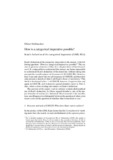Citation link:
https://nbn-resolving.org/urn:nbn:de:hbz:467-10288Files in This Item:
| File | Description | Size | Format | |
|---|---|---|---|---|
| How_is_a_categorical_imperative_possible_Schoenecker.pdf | 619.46 kB | Adobe PDF |  View/Open |
| Dokument Type: | Book Part | metadata.dc.title: | How is a categorical imperative possible? : Kant’s deduction of the categorical imperative (GMS, III,4) | Authors: | Schönecker, Dieter | Institute: | Fakultät I Philosophische Fakultät | Dewey Decimal Classification: | 100 Philosophie | GHBS-Clases: | JIQI | Issue Date: | 2006 | Publish Date: | 2016 | Source: | Horn, Christoph (edt.) ; Schönecker, Dieter (edt.): Groundwork for the Metaphysics of Morals. Berlin ; New York : de Gruyter, 2006. - ISBN 978-3-11-017707-7, S. 301 - 324 | Abstract: | Kant’s deduction of the categorical imperative is the answer to the following question: “How is a categorical imperative possible?” The answer is given in subsection 4 (Sec. 4) of chapter three of the Groundwork. It is impossible to understand this answer, and hence impossible to understand Kant’s deduction of the moral law, without taking into account the overall context of Groundwork III (GMS III). However, here I can only sketch the overall structure of GMS III, and therefore only present a sketch of what I call Kant’s thesis of analyticity.1 This thesis is developed in Sec. 1 of GMS III; however, it appears time and again in GMS III, and it deserves special attention (part 1). Part 2, then, offers a close reading and analysis of Kant’s deduction. |
URN: | urn:nbn:de:hbz:467-10288 | URI: | https://dspace.ub.uni-siegen.de/handle/ubsi/1028 | License: | https://dspace.ub.uni-siegen.de/static/license.txt |
| Appears in Collections: | Publikationen aus der Universität Siegen |
This item is protected by original copyright |
Page view(s)
900
checked on Nov 25, 2024
Download(s)
716
checked on Nov 25, 2024
Google ScholarTM
Check
Items in DSpace are protected by copyright, with all rights reserved, unless otherwise indicated.

